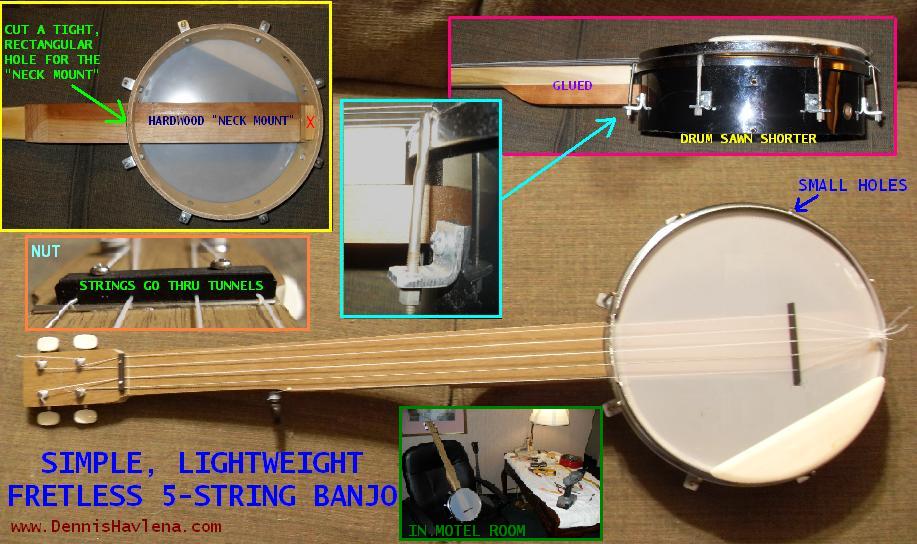
Dimensions of tuning head: 53mm wide by 106mm long (I reduced the head thickness to better accomodate the tuning gears shafts) Width of neck at nut is 42mm. Where it meets the drum it measures 51mm. Bridge dimensions: 70mm long by 14mm high by 5mm thick - tapered to 2mm wide at the top. String-length is 642mm. Overall spacing of the four playing strings at the nut: 31mm. Overall spacing of the five strings at the bridge: 51.5mm (I really like wide spacing). Of course you can alter the neck and other dimensions to suit your preferences. Because there is no tailpiece & the "outer" strings papproach the bridge at quite an angle, you need to groove each string-slot a bit deeper than normal to keep them from popping out. Because the normal rock drum's head-tensioning rim extends above the level of the surface of the skin head, it is necessary to bend down & fold-over that part of the rim so the strings can pass over. This is easy to do, just hacksaw two slots then (using a pair of Vise-Grips) carefully and slowly bend down this part of the rim outwards until every part of it is below the level of the skin head. After that is done, ensure (again with Vise-Grips) that the newly bent part is equal to or less than the thickness (as from looking above) of the rim thickness -- this is done so that it will not interfere once the end of the neck is mounted. I drilled (& carefully de-burred/smoothed) a 3/16" (a little less than 5mm) hole that the five strings tie to (using bowline knots). This banjo thus needs no tailpiece. The most "labor-intensive" part of this project is roughing out & shaping the neck. I'd have been better off if I could have done this at home instead of the motel room, but still, it wasn't too much of a deal - using hand saw, coping saw, "sure-form" type of hand-held wood shaper (they bite on the pull), files and sandpaper did the trick. Main concern here was that I didn't disturb nearby motel-room guest's, or get kicked-out of the place -- so I shut myself up in the bathroom for this relatively noisy process. Note that the underside of the neck (where your left hand's palm rests) need not be contoured that much. Very carefully plot the location for cutting the rectangular "neck mount" hole so that the top surface of the neck itself is flush (at the same height) with the top surface of the drum-head. Try your best to make the "neck mount" fit somewhat tightly through the rectangular hole (by doing so, nothing need be glued here). As for actual cutting of the hole, I drill holes just inside from each of the 4 corners & then, using a bare hacksaw blade and files, shape the rectangle -- checking the fit regularily. The small block (at red "X" in photo) is not needed. It was just an experiment here. With some strings on & tensioned, carefully move the end of the "neck mount" up and down until the desired bridge-height, string-height/"action" is determined, then install a screw through the drum rim and into the end of the "neck mount". If you goof up here, it's easy to relocate the screw. The arm-rest is slicone-glued on. Works fine. The ebony fiddle peg (for the 5th string) is quite easy to install. I don't own an expensive tapered reamer normally used to fit such friction pegs, but over the years have had great success using a series of flat-bladed screwdriver ends (you can even easily file the ends to match the taper of the peg), file ends, etc (use your imagination) to slowly "worry" an approximation of the proper taper, once the guide hole (same size as the peg's smallest part) is drilled. Go slowly & test-fit the peg often. The nylon 5th string has very little "pull" so the tapered fit doesn't have to be very "accurate" to keep the peg from slipping. Failing this, an inexpensive mechanical 5th string peg can certainly be used. elderly.com sells these for under $10. * With metal strings, a dense, hard wood such as ebony might make too harsh a tone but after experimnentally using such an all ebony bridge with NYLON stringed instruments (not just this fretless one), that's all I use now! I believe that ebony bridges noticeably improve the sound of nylon string banjos. Dennis Havlena - W8MI www.DennisHavlena.com
Click here to access my webpage